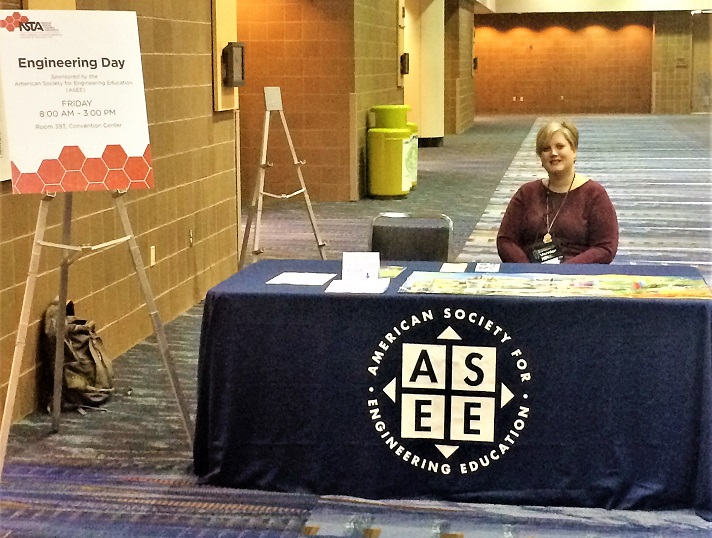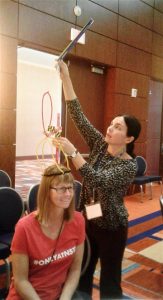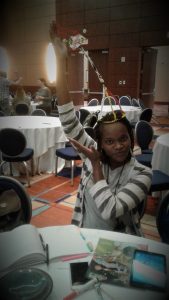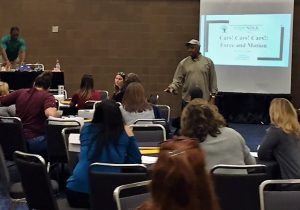ASEE Engineering Day Highlights

Photo: ASEE volunteer and teacher Becky Smith welcomes participants to ASEE’s Engineering Day sessions at NSTA conference in New Orleans on December 1, 2017
Couldn’t make it to ASEE’s hands-on Engineering Day sessions at the National Science Teachers Association regional conferences or the annual STEM Forum in 2017?
Here are some highlights from the hands-on activities – plus a roster of ASEE and other resources to help you teach engineering in engaging, authentic ways. Our engineering educators and volunteers will be presenting at the NSTA STEM Forum in Philadelphia July 11-13, 2018. See you there!
STEM Forum & Expo (Orlando, July 2017)
Bringing Polar Research to Your Classroom
ASEE Volunteers: Philipp Boersch-Supan, University of Florida, and Liesl Hotaling, Eidos Education
Polar-ICE (Polar Interdisciplinary Coordinated Education) is a National Science Foundation-funded program designed to connect scientists, educators, and students using data and research from the Arctic and Antarctic regions.
- Click HERE for the session’s presentation [PDF], including polar research activities on piloting gliders and studying penguins, and links to the polar bear contest for students and other research.
- This two-page handout [PDF] from the session includes links to other classroom activities, including penguins foraging and a link to films about the people, creatures, and geology of the polar region.
Hotaling’s SENSE IT program, a research-proven curriculum in which high school students construct and deploy sensors to monitor the health of their local rivers and other environments, includes four four-class-period modules on using sensors in the environemnt, and curriculum resource guide.
NSTA Regional Conference, Baltimore (October 7, 2017)
Design a Preakness Hat [grade level: K-12] [15 minutes] 
ASEE Volunteer: Pamela Lottero-Perdue, Towson University
Many pipe cleaner design challenges involve building the tallest tower. Dr. Pamela Lottero-Perdue, former chair of ASEE’s Pre-College Division and an education professor at Towson University in Maryland, made the activity more inclusive and appealing by challenging teachers to design a tall hat for Maryland’s famous Preakness Race that not only can stay on one’s head for at least 10 seconds but also contains a correctly colored state flag.
Download Activity [PDF]
Problem: You have come to the Preakness with no hat to wear! (Gasp!) The Preakness is a famous horse race at the Pimlico race track in Baltimore, Maryland. People like to wear fancy hats to the race.
Goal: To engineer a hat that displays Maryland pride.
Constraints: Good news! Your team is prepared for this kind of situation. You gather the following items from your cars and teaching bags:
- 16 fuzzy sticks
 Some clear tape (just 5 cm of tape left – drat!)
Some clear tape (just 5 cm of tape left – drat!)- Crayons and scissors
- A State Flags coloring book; it has a ready-to-color image of the Maryland flag. See PDF for template.
You’ve got 12 minutes to create your first attempt at a Maryland Pride Preakness hat. Criteria: Your hat should: 1. Support itself for least 10 seconds on a team member’s head without falling off.
Cannot Support Itself = 0 points Can Support Itself = 3 points 2. Include a correctly colored Maryland flag. Incorrectly Colored = 0 points; Correctly Colored = 3 points. Hold the flag as high as possible; higher is better; measurement is from top of head to bottom of flag. 0 – 10 cm = 0 points; 11 – 20 cm = 1 point; 21 – 30 cm = 2 points; 31 – 40 cm = 3 points, and so on …
Also in Baltimore:
Kindergartners Trying and Trying Again to Engineer Solutions to Problems [K-1]
ASEE Volunteers: Pamela Lottero-Perdue (Towson University: Towson, MD), and Michelle Bowditch, Tedra Webb, and Michelle Kagan (Hall’s Cross Roads Elementary School: Aberdeen, MD)
- Hexbug Maze design challenge overview. [PDF]
- Maze_Parts_Page.pdf
- Sliding_Discs_-_Short_Slide_Sheet_v1.pdf
- Sliding_Discs_-_Long_Slide_Sheet_v1.pdf
- Sliding_Discs_-_Angle_Slide_Sheet_v1.pdf
- Ramp_Part_of_Activity.pdf
- Sliding_Discs_Part_of_Activity.pdf
- Hexbug_Maze_Challenge_Design_Brief.pdf
- Teacher_Tips_from_Presentation.pdf
- Oscar and the Cricket
- Science and Children article describing activities related to Hexbugs and blocks (free to NSTA members, and $.99 for nonmembers)
Simple Electric Circuits [Grades 6-8]
ASEE Volunteers: LaDawn Partlow and Jumoke Ladeji-Osias (Morgan State University, Baltimore, MD)
Simple circuits presentation [PDF]
NSTA Regional Conference, Milwaukee (November 10)
Engineering Education: Simple Electronics and Microcontrollers for the Classroom [Grades 1-12]
ASEE volunteers: Andrea Burrows and Mike Borowczak (University of Wyoming, Laramie, WY)
Basic electronics hands-on activity that involves building a circuit with LEDs, light sensor, and a microcontroller (e.g. Arduino and Raspberry Pi)
Click HERE for presentation [ppt] on activity and connection to the Next Generation Science Standards. Click HERE for lesson plan, activity, and assessments [PDF] – courtesy of Australian Broadcasting Co. Science.
Can you make the light bulb glow?
Objective: In this activity, you will try to make an electric current flow through a circuit. You will know the instant you are successful because the light bulb will glow! When you have mastered your simple circuit, experiment with other ways to make the circuit, or devise a simple switch.
Inside a light bulb For such a successful invention, light bulbs are pretty simple things. Take a closer look inside your light bulb (use a magnifying glass if you have one). Inside is a filament that looks like a tiny spring. The filament is made from a type of metal called tungsten. It is attached to two tiny metal posts. One of these posts is connected to the outer metal case. The other post is connected to the metal part of the bulb’s base. When electricity flows through it, the tiny filament heats up to more than 2000 degrees Celsius! At these temperatures, tungsten usually reacts with the oxygen and burns out very quickly. To protect the filament from oxygen in the air, light bulbs are filled with a special gas called argon. Argon doesn’t react with tungsten so the bulb can glow for hundreds of hours. Safety note: You are using very safe low voltage light bulbs and batteries which are safe to touch. Never touch household light bulbs – they can become very hot!
Procedure
1. How does a flashlight work? Before you begin experimenting, try drawing the inner workings of how you think a flashlight works in your science journal. Include the battery (or batteries), light bulb, and switch.
2. Make aluminium foil wires. To make a simple, strong wire for your experiments, take a rectangular piece of aluminium foil about 30 × 15 cm and fold it in half. Keep folding the foil this way until you have a long flat ‘wire’ about 1.5cm wide.
3. Making current flow. Using your aluminium wires, battery, light bulb and any other items you have at your disposal, try to make a complete circuit. When you are successful, electric current will flow through the wires and the light bulb so that it glows bright.
4. Make improvements. When you have mastered making a current flow, experiment with ways to make your circuit more sturdy. Use whatever items or materials you have at your disposal to improve your design. You might even design an on/off switch. If something doesn’t work after a few attempts, just stop and look for another way to make your idea work. What have you discovered? When you have finished experimenting, use what you have learnt to draw another picture of how you think a torch works. Does your new drawing match the one you made earlier? Can you describe what you have learnt about how electric currents flow?
Also at ASEE Engineering Day in Milwaukee:
NGSS, 3-D Learning, and the Design and Use of Classroom Assessment [Grades 6-12]
How to conceptualize and design classroom assessments that meet the NGSS.
ASEE volunteers: Brian Gane and Sania Zaidi (University of Illinois, Chicago)
- Click HERE for workshop presentation [PDF] and “Birds, Bees, and Cherry Trees” activity
- Click HERE for workshop activity critiquing two assessments of student learning
- Click HERE for Fairness and Mindfulness Criteria for Designing & Evaluating Assessment Tasks for Formative Use
- Click HERE for task rubric for “Birds, Bees, and Cherry Trees.”
- Click HERE for task rubric for “Locusts Migrate toward Cotton Farms.”
From Concord Consortium’s Next Generation Science Assessment (NGSA) and sample NGSA Tasks project
ASEE @ NSTA in New Orleans (December 1) 
Using Engineering and Coding to Make Science Stick [grades 5-9]
A traditional science curriculum was transformed into a progressive problem-solving course without sacrificing science teaching by incorporating engineering and coding.
ASEE volunteers: Stephanie Zeiger and Rebecca Smith (Harpeth Hall School, Nashville, TN)
(Photo: Calvin Mackie of STEM NOLA presents Cars! Cars! Cars! Force and Motion! for ASEE Engineering Day at NSTA’s regional conference in New Orleans)
- Click HERE for the presentation and activity. [PDF]
- Click HERE for list of resources and guidance on buying toy parts [Word doc].
How will YOU use engineering to make science topics stick?
- Pick a science topic you want to try this with and decide on a problem to solve (get inspiration from real life)
- Pick an Engineering Design Process and use it consistently
- Put the science learning into the “Ask” phase of the EDP
- Let students solve the problem – they will naturally use and apply the science you want them to learn
When you assess students . . .
- Require documentation of the process
- Consider individual reports even with group project
- Don’t emphasize success of the prototype
STEAMed Up About STEM
Becky Smith, who teaches at an all-girls school in Nashville, led a well-received session on how she uses short features from ASEE’s Prism magazine in her classroom.
She cuts out First Look items – which are also available online – and glues them on a large index card. On the back, she lists questions for students to answer. “I love this opportunity for students to practice reading comprehension and get a nugget of information about engineering in a bite-size piece, with no pressure to understand technical details,” she reports.
Here are the questions:
- Describe the problem that needed solving in one sentence.
- What is one example of a scientific concept that had to be understood in order to solve the problem? (this does not need to be explicitly stated in the passage)
- Make a connection: Finish one of these prompts:
o This reminds me of . . . .
o This is similar to . . . .
o This is different from . . . .
- Ask a question: Finish one of these prompts:
o What would happen if . . .?
o Why did . . .?
o I don’t get the part where . . .
Extra credit reading: Is it Engineering or Not? (NSTA, Summer 2017)
Filed under: K-12 Outreach Programs, Special Features, Web Resources
Tags: American Society for Engineering Education K-12, ASEE, assessment design, Class Activities, Design, Energy, force and motion, Harpeth Hall School, Liesl Hotaling, NGSS, NSTA, penguins, polar ice, polar research, Resources for Teachers, sensors, STEM education, STEM NOLA, Web Resources








